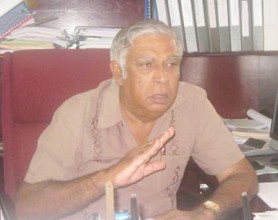The wave of criminal violence that erupted on the East Coast was the most severe and sustained spell of murder in the country’s history.

The crimes committed between 2002 when Andrew Douglas and the other desperadoes escaped from prison and 2008 when Rondell ‘Fineman’ Rollins and his cohorts were killed, triggered several official counter-crime responses.
The Administration experimented with boosting the long-established Community Policing Groups, introducing a Neighbourhood Policing Programme and contemplated a Crime Stoppers Scheme. None seemed to offer prospects for a long-term solution to criminal violence. It then sought the assistance of the British Government but the Security Sector Reform Action Plan which was agreed between the two sides was abandoned soon after it started.
The administration’s request for financial support from the Inter-American Development Bank for its counter-crime strategy seems to be bearing fruit. The Bank agreed to finance a Citizen’s Security Programme on the pattern of those it financed in Colombia, Chile, Honduras, Nicaragua and Uruguay. It approved a US$19.8M loan to the Guyana Government to support the programme four years ago in June 2006. The Bank’s resident representative Sergio Varas-Olea signed the contract for the programme with Minister of Finance Dr Ashni Singh in the presence of Minister of Home Affairs Clement Rohee the following year, in January 2007. Mr Varas-Olea recalled that “We have worked in Guyana for three years, analysing the situation” before an agreement was reached.
But, even as the wave of criminal violence continued to claim more lives – including the Lusignan, Bartica and Lindo Creek massacres which all occurred in 2008 – and crimes against the person soared elsewhere in the country, implementation of the Programme moved slowly. At one stage, it was suspended for a year in 2008-2009 to enable “a review of its structure.”

The Programme aims at strengthening the capabilities of the Ministry of Home Affairs and the Guyana Police Force to implement crime prevention programmes at the national and local levels and to strengthen social cohesion at the neighbourhood levels within communities.
It seeks also to identify, prevent and counteract risk factors and increase and promote protective factors in communities, families and individuals. For this reason, the Programme is divided into three components – the modernisation of the Ministry of Home Affairs, modernisation of the Guyana Police Force and the Community Action Component.
According to Government Information Agency releases, in the first instance, the Programme will spend US$4.48M to strengthen the Ministry’s capacity in the formulation and the evaluation of evidence-based policies and the improvement of its overall institutional performance. In the second instance, it will spend US$7.95M to help to transform the Guyana Police Force from an incident-driven and reactive institution to one that relies on the analysis of patterns, incidents and problems to enhance its capacity in addressing solutions to the causes of incidents.
The launch of the Integrated Crime and Violence Information System – commonly called the Crime Observatory – in March signalled the Programme’s institutional strengthening of the Police Force. The System’s key component will be its capacity to integrate the work of the Police Force with a number of agencies – such as the Guyana Prison Service; the Guyana Revenue Authority; Department of Public Prosecution and the Magistrates’ Courts – which are vital to crime and security. The System, within the Force, will enable the establishment of data centres at its headquarters and the Ministry of Home Affairs and the integration of all police stations in a wide area network.
The System will ensure that all criminal occurrences that are reported at police stations throughout the country can be viewed and analysed at Police Force headquarters and all other divisions.
The Community Action Component of the Programme, that was re-structured and re-launched only six months ago in February, is the third arm of the Programme. This component will now be aimed at young persons and school dropouts between the ages of 14 and 25 years from ten communities. Young persons in the Programme will be able to benefit from training in skills, building business capacities and from literacy and numeracy classes.
According to Khemraj Rai, the Programme’s Coordinator, young people will participate in workshops and seminars to instill in them the “moral responsibilities that will enable them to become responsible and productive citizens.” As he sees it, community action “is an effort to deter youths from getting attracted to crime and criminal activities.” Each community, he thinks, will “become sustainable as a neighbourhood in which all persons are included in the creation of a safe environment and young people are provided with opportunities that will prevent them from participating in criminal and violent activities.”
At a glance, the structure of this component seems bureaucratic and formalistic. The Ministry of Home Affairs is meant to assist selected communities to form Councils. Each community will identify three ‘rapid impact’ projects and nominate young persons to participate in the Programme. Each community will then be given US$5,000 to expend on each project. With guidance and resources from the Ministry, projects could include tasks such as the rehabilitation of recreational centres and the procurement of equipment and books.
An executive committee will then be elected and, in turn, it will nominate a Community Action Officer who will be tasked with monitoring the activities of the Council.
Mr Rai explained that the revised Programme will involve ten communities, five of which have been identified already by the Government. These communities – Rose Hall and Port Mourant in the East Berbice-Corentyne Region and Buxton, Annandale and Sophia in the Demerara-Mahaica Region – were selected. It seems that the rationale was that they were either touched by the troubles or might be vulnerable to other forms of violent crime. Consideration has been given to including Lusignan and Agricola Villages, for similar reasons.
Ms Roseanne Purnwasie, the Community Action Specialist who coordinates the Community Action Component, emphasised that the main objective of community action is to encourage young persons to “realise their responsibilities and to boost youth self-esteem by enhancing their capacities, thereby breaking the culture of violence and crime in society.” The crime and violence prevention strategy will include skills and vocational training for young persons under the age of 25 who have dropped out of school and have no form of documentation to verify that they are employable. Ms Purnwasie accepts the fact that some school dropouts may need remedial education in literacy and numeracy.
This project will be executed through a six-month training course by facilitators within, or from nearby, communities. It will include entrepreneurial training for young persons who have the aptitude to run their own businesses. The Programme will provide appropriate training to assist them to start up their own businesses and trainees will be linked in an apprenticeship or internship scheme with established businesses.
The proposed Citizens’ Security Programme is ambitious in scope. It aims not only at enhancing public security but embraces essential aspects of education, employment and youth policy. The administration is correct in having come to the conclusion that the unemployment of young persons has been a contributory factor to crime. But it has travelled this road before and should be aware of the pitfalls.
The administration established a National Youth Commission and a National Youth Parliament; launched the President’s Youth Choice Initiative; adopted the Duke of Edinburgh Award renaming it the President’s Youth Award – Republic of Guyana Programme; initiated the National Training Programme for Youth Empowerment and considered creating a Youth Development and Empowerment Programme. Yet, despite lots of projects there has been little measurable progress. Thousands of semi-literate, young persons still drop out or leave school every year and find it difficult to secure employment.
The question is how relevant is the Programme – particularly the Community Action Component – to this country’s actual public security needs? Mr Rohee himself, back in August 2008, complained that there were “difficulties” in the implementation of the Programme’s Community Action Component. He had sought to suggest that the Inter-American Development Bank was attempting to define the realties in Guyana. According to him, “The Government of Guyana has taken a position that it wishes to redefine the community component of the Citizens’ Security Programme…We are not satisfied with how it is currently defined in the agreement.” He argued, “We know what the realities are in Guyana, and we do not need the Bank to tell us what the realities are. If we want the Programme to be redefined, the Bank has to redefine the Programme to be consistent with the social and economic realities of Guyana.”
The Programme has now been re-structured. The danger remains, however, that it might still not be fully relevant to this country’s home-grown security problems. It also might not have the capacity to accommodate or the capability to provide the quality of remedial education and skills training to the large number of young persons who drop out of schools every year.
Developed by the Washington Office on Latin America to suit post-civil war situations in Latin American states such as El Salvador, Guatemala and Haiti, the Bank has financed similar programmes in Colombia, Chile, Honduras, Nicaragua and Uruguay. These countries, however, all have completely different criminal, communal and cultural profiles to coastal Guyana.
The Programme does not appear to have incorporated the administration’s numerous efforts and experiences in youth development over the past 18 years. Even in its revised mode, it would be challenged to attempt to remedy the specific educational deficiencies – such as literacy and numeracy, much less instilling the “moral responsibilities that will enable them to become responsible and productive citizens” – which still bedevil the formal education system.
The Programme seems to have been tailored to deal only with certain communities in the troublesome Demerara-Mahaica and East Berbice-Corentyne regions. It is not national in scope and ignores the danger of organised crime such as narcotics-smuggling, gun-running and trafficking in persons. These crimes have their sources in the Cuyuni-Mazaruni, Potaro-Siparuni and other hinterland regions but contribute to crime in the rest of the country.
The Citizen’s Security Programme is an important initiative. Efficiently administered, it could become a public good by improving the lives of thousands of young persons.





